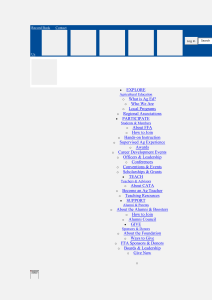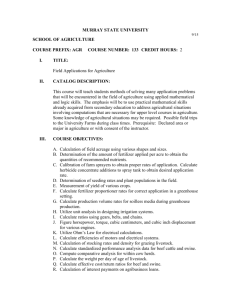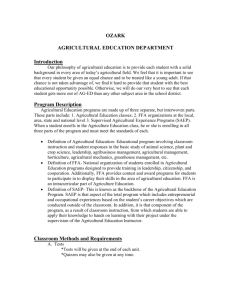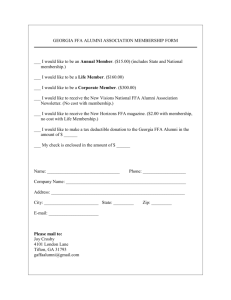Strategies of Effective Teaching
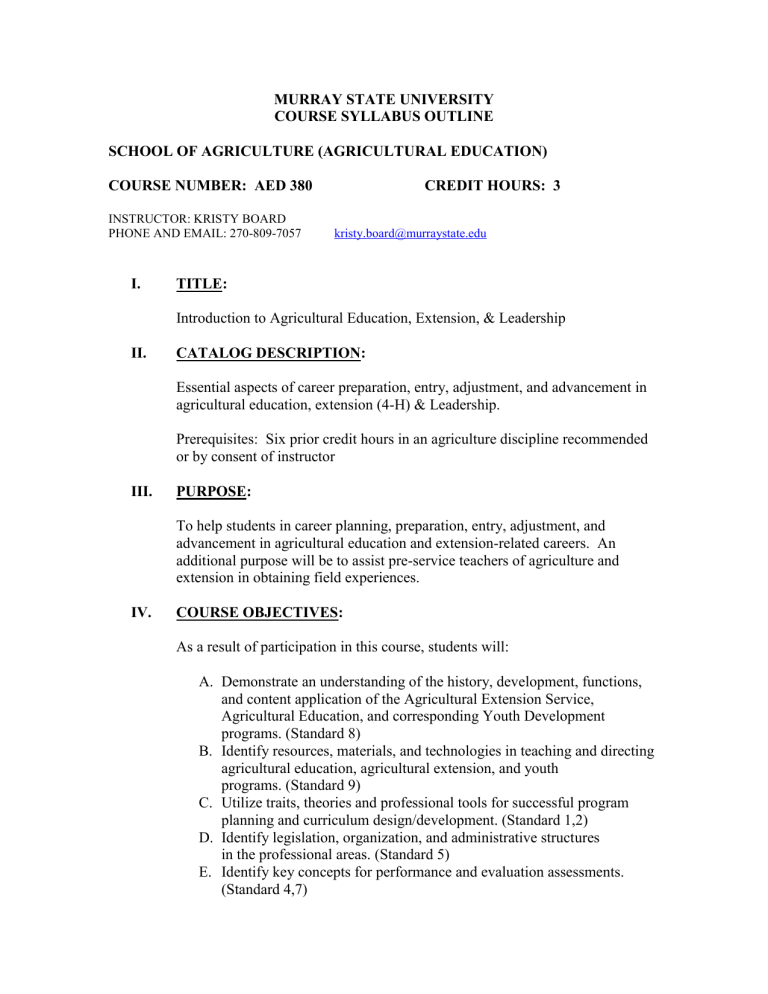
MURRAY STATE UNIVERSITY
COURSE SYLLABUS OUTLINE
SCHOOL OF AGRICULTURE (AGRICULTURAL EDUCATION)
COURSE NUMBER: AED 380
INSTRUCTOR: KRISTY BOARD
PHONE AND EMAIL: 270-809-7057
CREDIT HOURS: 3 kristy.board@murraystate.edu
I.
TITLE:
Introduction to Agricultural Education, Extension, & Leadership
II.
CATALOG DESCRIPTION:
Essential aspects of career preparation, entry, adjustment, and advancement in agricultural education, extension (4-H) & Leadership.
Prerequisites: Six prior credit hours in an agriculture discipline recommended or by consent of instructor
III.
PURPOSE:
To help students in career planning, preparation, entry, adjustment, and advancement in agricultural education and extension-related careers. An additional purpose will be to assist pre-service teachers of agriculture and extension in obtaining field experiences.
IV.
COURSE OBJECTIVES:
As a result of participation in this course, students will:
A.
Demonstrate an understanding of the history, development, functions, and content application of the Agricultural Extension Service,
Agricultural Education, and corresponding Youth Development programs. (Standard 8)
B.
Identify resources, materials, and technologies in teaching and directing agricultural education, agricultural extension, and youth programs. (Standard 9)
C.
Utilize traits, theories and professional tools for successful program planning and curriculum design/development. (Standard 1,2)
D.
Identify legislation, organization, and administrative structures in the professional areas. (Standard 5)
E.
Identify key concepts for performance and evaluation assessments.
(Standard 4,7)
F.
Define the role of county extension agents/educators in rural/urban development and collaborative arrangements with local and state agencies and individuals. (Standard 6)
G.
Determine the role of youth programs at the local and county level.
H.
Identify and enroll students in the Agricultural Education Pre-Service
Education Program & Admission to Teacher Education.
V.
CONTENT OUTLINE:
A.
Introduction to Agricultural Education
B.
Introduction to Agricultural Extension
C.
Introduction to Leadership Development in Organizations
D.
Making a Beginning and Advancing in Agricultural Careers
VI.
INSTRUCTIONAL ACTIVITIES:
A.
Group Discussion
B.
Areas Specific Resource Persons
C.
Group Presentations
D.
Audio-Video Presentations
E.
Field and Clinical Experience
VII.
FIELD AND CLINICAL EXPERIENCES:
A minimum of 15 clock hours of clinical experience outside regular classroom meeting times in a school setting.
VIII.
RESOURCES:
A.
Handouts
B.
Resource Personnel
C.
Field/Clinical Involvement
IX.
GRADING PROCEDURES:
CDE Paper/Proficiency
Group Presentation
Dual Lesson
Agriculture Leadership Project
Trip Itinerary and Budget
Creative Timeline Lesson
Pre Ag Ed Exam
Visit Summaries
Clinical Hours (15)
Agriculture Sales CDE
100
50
50
100
100
50
50
50
150
100
Service Learning Poster
Final Portfolio
GRADES CAN BE AMENDED
Grading Scales Will Be As Follows:
A= 90% C= 70% E= 59% or Less
B= 80% D= 60%
50
200
1050
X.
ATTENDANCE POLICY:
Attendance is expected at all class meetings and Extension Service Field
Functions.
XI.
ACADEMIC HONESTY POLICY:
(Adopted by the MSU Board of Regents)
Cheating, plagiarism (submitting another person’s material as one’s own), or doing work for another person which will receive academic credit are all impermissible. This includes the use of unauthorized books, notebooks, or other sources in order to secure or give help during an examination, the unauthorized copying of examinations, assignments, reports, term papers, or the presentation on unacknowledged material as if it were the student’s own work.
Disciplinary action may be taken beyond the academic discipline administered by the faculty member who teaches the course in which the cheating took place.
NOTE: The School of Agriculture Faculty have adopted and implemented an
Academic Honesty Policy in addition to the University Honesty Policy, which can be found in the current Undergraduate Bulletin and Graduate Bulletin .
The policy sets guidelines regarding acts of dishonesty and the procedure to follow should an event occur. It is each Agriculture student’s responsibility to obtain and read a copy of this document. The School’s Academic Honesty
Policy can be obtained by asking for a copy from any Agriculture Faculty member or the Secretary.
XII.
TEXT AND REFERENCES:
Strategies of Effective Teaching
Official FFA Manual, 2006 - 2007. National FFA Center
Mastering Parliamentary Procedure, 1983, Bender, Butler and Wooden
Gladwell, M. (2002). The Tipping Point; How Little Things Can Make a Big
Difference . New York, New York: Back Bay Books/ Little, Brown and
Company.
Resume: A Suggested Guide for Murray State University Students.
MSU
Cooperative Education and Placement Service.
XIII.
PREREQUISITES:
Six prior credit hours in an agriculture discipline recommended or by consent of instructor
XIV.
STATEMENT OF AFFIRMATIVE ACTION AND EQUAL
OPPORTUNITY:
Murray State University endorses the intent of all federal and state laws created to prohibit discrimination. Murray State University does not discriminate on the basis of race, color, national origin, gender, sexual orientation, religion, age, veteran status, or disability in employment, admissions, or the provision of services and provides, upon request, reasonable accommodation including auxiliary aids and services necessary to afford individuals with disabilities equal access to participate in all programs and activities. For more information, contact Sabrina Y. Dial, Director of Equal Opportunity, Murray State University, 103 Wells Hall,
Murray, KY 42071-3318. Telephone: 270-809-3155 (voice), 270-
809-3361 (TDD).
XV. MSU SCHOOL OF AGRICULTURE CELL PHONE POLICY
The School of Agriculture recognizes that in today’s world cell phones are a familiar and often necessary form of communication for students.
It shall be the policy of the School that no cell phone usage shall be allowed in class and/or labs without the prior consent of the course instructor. This shall include verbal calling, incoming calls, email, text messaging, and use of cell phone calculators on tests and quizzes.
Cell phones must be kept off and out of sight (i.e. secured to a person’s belt or kept in a bag or purse away from desks and lab counters).
Should a student’s cell phone be visible, ring, or other form of unauthorized usage that is interruptive to the class or lab, the student may be asked to leave class and not return for that class/lab period.
Upon prior consent of the instructor, a student may obtain permission to have their phone on in case of an emergency or in critical family situations.
This policy also includes pagers and other electronic equipment such as blackberries and/or computers/laptops.
Bibliography
Borich, G. (2004). Effective Teaching Methods. (5 th
Ed.). Pearson/Merrill Prentice Hall:
Upper Saddle River, New Jersey & Columbus, Ohio.
Cuban, L. (2003). Why is it so Hard to Get Good Schools?. Teachers College Press:
Columbia University, New York and London.
Guiler, G., & Woodin, R. (1994) Mastering Parliamentary Procedure. Columbus, Ohio:
The Ohio State University.
Jeffiers, D. (1988). Effective County 4-H Councils: A Guide to Their Organization and
Function. Lexington, Kentucky: University of Kentucky.
Jones, F. (2000). Tools for Teaching. Hong Kong
Lucas, A (1996). 4-H Club Leader’s Handbook. Lexington, Kentucky: University of
Kentucky.
National FFA Center, (2006). National FFA Manual. Indianapolis, Indiana: National FFA
Supply Service.
National FFA Center, (2006). The FFA Handbook. Indianapolis, Indiana: National FFA
Supply Service.
Seevers, B., Graham, D., Gamon, J., & Conklin, N. (1997). Education Through
Cooperative Extension. Albany, New York: Delmar.
Zemelman, S., Daniels, H., & Hyde, A. (1998). Best Practice: New Standards for Teaching and Learning in America’s Schools. (2 nd
Ed.). Heinemann: Portsmouth, New
Hampshire.


